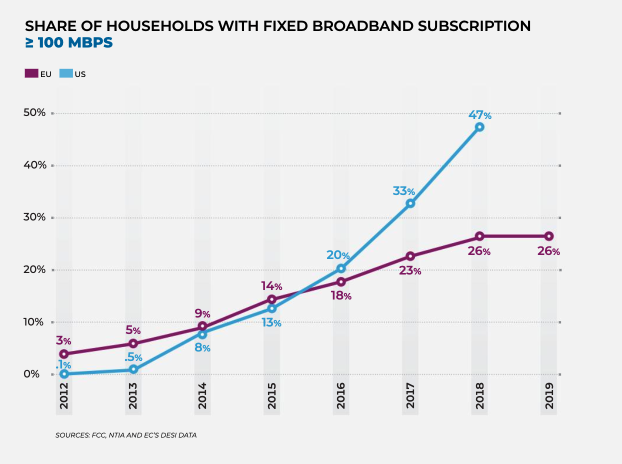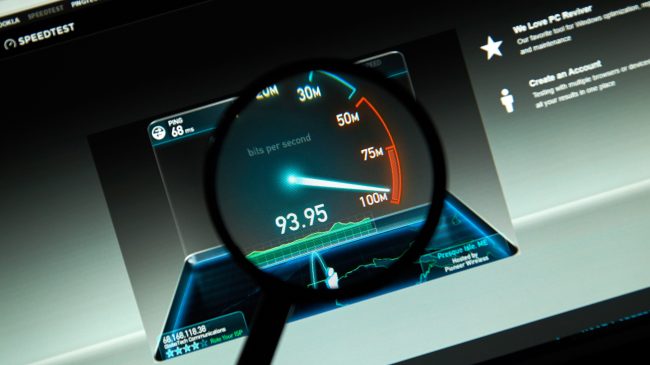The following public comment was submitted to the Federal Communications Commission on December 14, 2023.
Reason Foundation supports an open and free market for broadband services. This proposed rule change would, among other things, classify broadband providers as a service under Title II of the Communications Act, effectively making it a public utility like electricity and undermining the effectiveness of the free market.
The Federal Communications Commission (FCC) correctly observes in its request for comments that online life has become more prominent than ever, particularly after reliance on digital means of communication rapidly increased during the pandemic. However, the FCC further observed that no federal agency ensures the internet is “fast, open, and fair.” Despite this lack of regulation, the internet possesses all of these qualities and will continue to so long as it remains part of a free market.
Today, the ability to connect to broadband internet, defined as 25 megabits per second (Mbps), is available to 96% of Americans, with the remaining 4% in rural areas. Roughly 50% of Americans are subscribed to 100/Mbps+ speeds, while 9% are subscribed to services with 250/Mbps speeds or higher. Roughly 43% of Americans already have access to fiber internet at home, with some large states like New York achieving 64% coverage. Speed tracking service Ookla reported in September 2021 that “Americans are currently getting around 204/Mbps … nearly double the global average.” These data show that besides a few rural areas, the U.S. is mostly blanketed in broadband networks.
One test conducted in 2021 looked at the typical family internet use. It evaluated the following simultaneous consumption:
- 1 online gaming session
- 1 video chat session
- 1 4k video stream
- 1 HD video stream
- And miscellaneous online use (email, chat, browsing, etc.)
For the listed activities, the total amount of bandwidth used was only 24.2/Mbps. The Biden administration is proposing a minimum of 100/mbps download speed as a speed minimum for every American. A 2018 test by Princeton University and The Wall Street Journal showed that 100/Mbps users, even when running seven video streams simultaneously, use only 7.1% of the broadband capacity available to them. One study of bandwidth usage found that 4K streams, on average, only used 10.9/Mbps. These real-world use studies show that consumers typically don’t push the limits of their broadband networks even when conducting data-intensive activities simultaneously.
Without a federal agency directly overseeing and funding the process, the United States has constructed one of the highest-performing networks in the world. This has been brought about partly by billions of private investment dollars because investors can charge market rates and make investment returns.
But even if the current networks are mostly sufficient, they will eventually need investment. The proposal correctly observes that broadband investment decisions vary with many factors like economic conditions, but then erroneously argues that changing to Title II would only positively affect investment.
The FCC states, “We do not anticipate that the open internet rules we propose today will have a harmful effect on investment.” The commission argues, “Without an open internet, there would be less broadband investment and deployment.”
The FCC asserts that this will help even “edge” internet service providers (ISPs) and consumers who may exist outside of the main urban areas of coverage: “We believe the conduct rules we propose will protect edge innovation and the ability of consumers to access those new and developing services, thereby promoting both edge and ISP investment.”
The proposal then claims that Title II status will make the recent influx of $42 billion in funding from the federal government for broadband deployment even more effective:
“We believe that ensuring the protections of section 224 are restored to all ISPs, including broadband-only providers, will pave the way for quicker and less expensive broadband deployment, thereby enabling that funding to go as far as possible”
However, data from the European Union (EU), the closest comparable area to the United States, where net neutrality has existed since 2015, shows that regulated networks do not receive as much investment or perform as well. In 2014, one year before the EU implemented net neutrality, the U.S. and the EU had equal coverage of fixed broadband faster than 100/Mbps at roughly 15%. Yet, by 2019, the U.S. had swelled to over 47% while the EU lagged behind at 26% coverage.

This increase in coverage is most likely driven by higher investment. The cumulative investment from 2012-2018 in the EU was $353 billion compared to $616 billion in the U.S. U.S. providers invest up to three times more per household, equating to roughly $700 per household every year. This results in an average increase of 30/Mbps and superior mobile internet speeds in U.S. households compared to the EU.
Studies evaluating the impact of the 2017 change from Title II back to Title I are flawed because they consider too short a time period, do not account for economic forces, and do not make larger comparisons such as comparing the U.S. to the. EU. While the change appears to present a convenient natural experiment for a time series analysis, it fails for the reasons above, and a comparison between the U.S. and EU over a more extensive period is more representative of the intended analysis.
As the net neutrality scheme plays out in the EU, financial pressure is building because ISPs cannot increase rates for customers with higher usage rates. Regulators are now proposing that the heaviest traffic users, like Google, Meta, and Netflix pay an extra fee to telecom operators for their increased volume. This regulation would be a “non-neutral” net neutrality scheme where firms that use more traffic pay more. Such a proposal would mimic what the United States already has, but instead of a more robust market mechanism, the price would be set by regulators. A market system would allow operators to charge fair market prices without government involvement.
If technologies like virtual reality or other data-intensive applications ever become as mainstream as smartphones and streaming, ISPs will need the flexibility to upgrade or construct new networks and be able to create revenue channels to support those expansions. While Title I may not necessarily spur investment, Title II certainly has the potential to suppress investment if such data-intensive applications cannot be given priority. This is evident when examining the EU’s comparatively weak investment and network data.
The COVID-19 pandemic tested the nation’s broadband and technical infrastructure. While ISPs and services in the private sector had trouble operating, many technical volume failures occurred in public sector networks. While not all of these were necessarily network-oriented, the government should fix its digital shortcomings before addressing a private sector system that significantly outperformed the public sector during a crisis. Taking that step would be a more efficient use of taxpayer dollars than regulating a broadband market that is performing relatively well.
We do not need a net neutrality scheme to make the internet faster or more open; more people have access to high speeds sufficient for modern activities than at any time in history. The free market in the U.S. has provided more investment, higher speeds, and broader coverage than net neutrality regions like the EU. Despite the necessity of broadband in modern life, a change to Title II would not make the internet faster, more open, or more fair.

